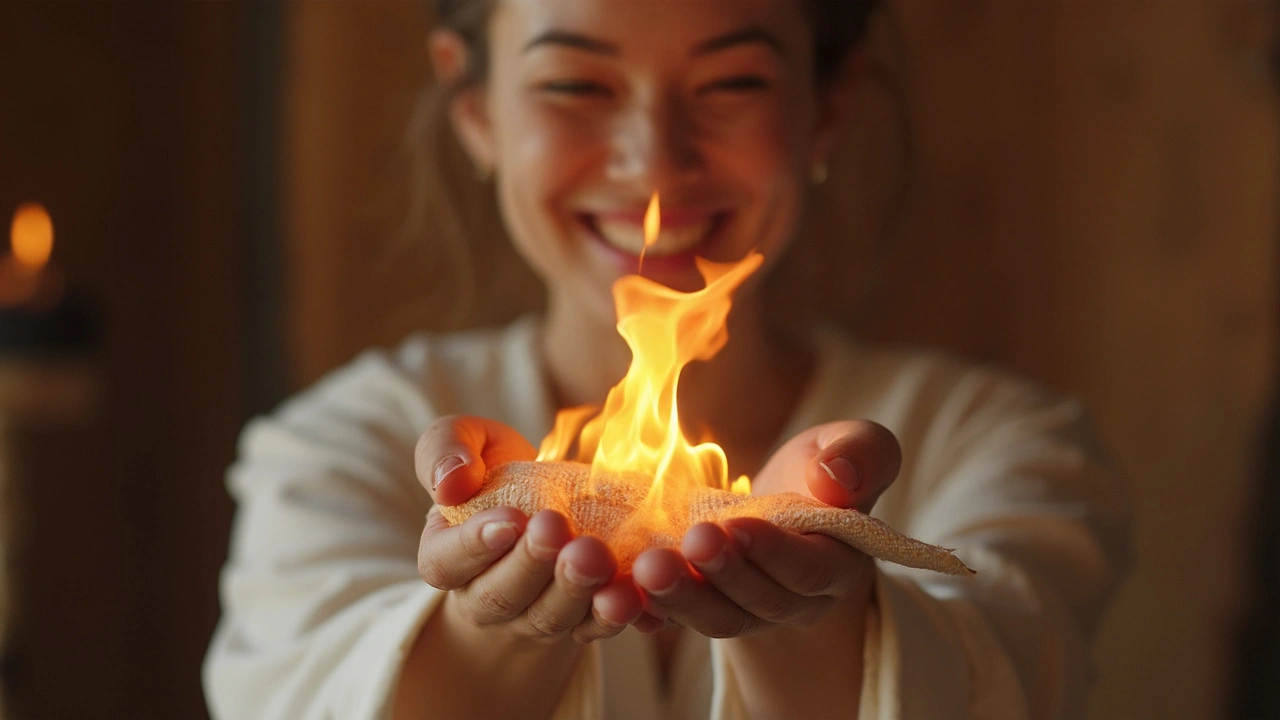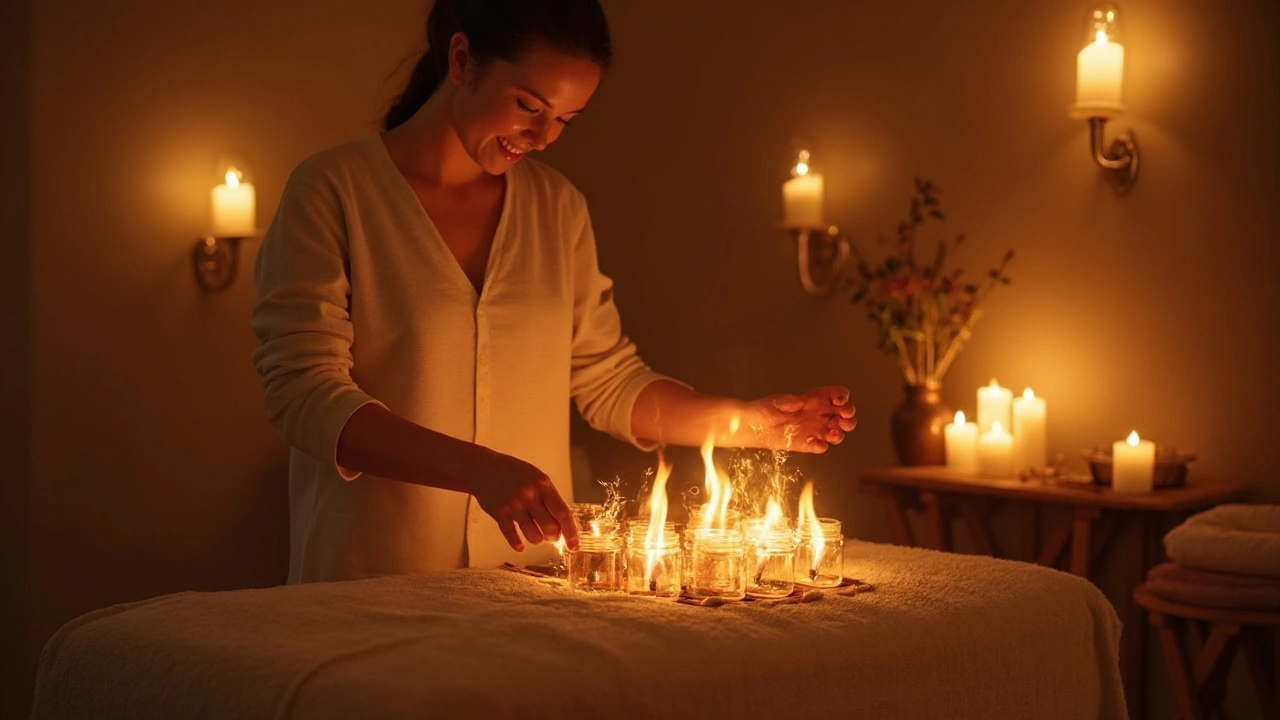It sounds wild at first: parts of your body getting gently set on fire. Not in a mad scientist’s lab, but somewhere in a quiet spa room with the scent of herbs and a therapist who looks oddly calm about the whole thing. Fire massage isn’t just another wild spa trend. In places like China, this technique has a long history in traditional therapy, and even in 2025, its bold promise of deep relaxation and healing is catching attention from curious minds and aching bodies worldwide.
What Really Happens During a Fire Massage?
You walk in and share your stress aches. The practitioner—the good ones are always calm—assesses you and starts rubbing in a mix of oils and sometimes herbal pastes. Here's where it gets real: they cover a towel or cloth with a special elixir, lay it on your back or legs, douse it carefully with a low-alcohol spirit, and then light it for a remarkably short moment. The flame, usually just a gentle whoosh, is quickly smothered. You don’t get burned—instead the heat penetrates, and, weird as it sounds, most people feel almost instantly soothed.
It isn’t just for the daredevils. If you peek at numbers from 2024, over 30% of urban wellness centers in Beijing and Shanghai offered fire massage on their menu. It’s even made its way to select spas in Europe and North America (just expect a price tag that matches the drama). Fire massage, or "Huǒ Liáo" in Mandarin, was first recorded in Chinese texts dating to the Qing Dynasty, when it was used to treat chronic aches, gout, and energy blockages.
Does it hurt? Not if it’s done right. Skilled therapists keep the flame in place for a matter of seconds, always with layers of wet towels, oils, and quick hands at the ready. Clients say the sensation is a rush of warmth that quickly melts into the muscles—a kind of heat that’s deeper and more enveloping than a hot stone massage. Some describe it as “a warm embrace from the inside out.”
What does all of this actually do? Traditional Chinese medicine practitioners say the heat drives out “cold” and “damp” energy—a poetic way of talking about deep muscle tension, sluggish circulation, and that bone-deep chill you feel in winter. Modern studies, while still fairly limited, back up a few of these claims: deep heat can boost blood flow, relax tissue, and help reduce certain types of pain. In a 2022 study out of Shanghai University of Traditional Chinese Medicine, participants with chronic shoulder pain reported faster pain relief after just two fire massage sessions compared to standard massage therapy.
There’s more than pain relief. Fire massage fans say it sparks energy, improves sleep, and helps with digestive problems. It’s not just about the body, either. The hypnotic crackle of fire and the trust you have to place in another person can have a calming effect on the mind—possibly helping anxiety melt away, at least for a little while.
| Fire Massage Benefits | Reported by Users | Supported by Studies |
|---|---|---|
| Pain Relief | 92% | Yes |
| Deep Relaxation | 89% | Limited |
| Better Sleep | 67% | No |
| Improved Circulation | 76% | Yes |
| Digestive Aid | 58% | No |
Curious if you’re cut out for this experience? If you’re ticklish, have phobias about fire, or get nervous at the idea of giving up control, fire massage might not be the start. But plenty of people who swore off “crazy” treatments a year ago now book regular sessions and swear their backs haven’t felt better in years. The drama turns out to be less about danger and more about waking up muscles, nerves, and maybe even a little bit of primal trust in your therapist.

Why Is Fire Massage Gaining Popularity?
Wellness trends come and go—one day it’s sound bowls, next month it’s goat yoga—but fire massage seems to stick around. Why? It combines mystique with real physical effects, plus there’s a surprising sense of ritual that makes you feel like you’ve stepped into another world. There’s something deeply nostalgic and oddly comforting about warmth, and in an age where cold, impersonal screens surround us, it’s not surprising people seek out therapies that literally heat things up.
Celebrities haven't missed out either—pop culture ran with videos of athletes and actors covered in flames (safely, of course), kicking off a wave of curiosity all over social media. Last winter, fire massage TikTok videos racked up over 350 million views globally, with hundreds of thousands sharing their reactions: shock, awe, and often deep calm. Unlike some fads, this one has a compelling story: ancient roots, visible results, and an experience you remember—sometimes even more than the benefit itself.
But let’s get down to why people are putting their trust—and a patch of their back—under a flame. The heat goes beyond the surface, loosening knots in ways that simple hot stones or infrared saunas can’t match. The flame draws blood to tight areas, rushes nutrients where they're needed, and carries waste products away faster. It’s a shortcut to muscle relaxation—one that leaves most people walking out lighter, looser, and sometimes downright glowing.
Another reason for the trend is the personalized touch. Most practitioners will mix herbal blends to help either invigorate, relax, or actually heal specific aches based on a quick health consult. Think ginger, cinnamon, or mugwort—all of which are used in Chinese medicine for their anti-inflammatory properties. So many clients say the afterglow lasts for days, and tension just doesn’t stick around like it used to.
Not everyone is ready for this therapy the first time. There's a mental hurdle in allowing someone to bring fire close to your skin, even with layers in between. But this very act, the willingness to trust, makes fire massage different from just another hands-only treatment. It’s a little bit primal—a reminder that we’ve always sought warmth and the power it brings to heal. It’s that spark—pun intended—that keeps fire massage from being “just another trend.”
Of course, safety looms large in all this. Not every spa is qualified. There are horror stories out there: untrained handlers, too much alcohol, or poor communication about pain thresholds. Always go to a certified therapist—preferably one with not only training but also a stack of safety certifications. Ask for references, and watch a session before signing up yourself. Don't hesitate to ask about the safety protocols, the origin of their training, and any backup measures they have in place.
People with certain health conditions should avoid fire massage. If you have thin or sensitive skin, circulatory problems, diabetes, or are taking blood-thinners, steer clear or at least talk to a doctor. For everyone else, if you’re curious and your local regulations allow it, it might be a new favorite way to chase off winter chills or post-workout fatigue.

Trying Fire Massage: What to Know and How to Get the Most Out of It
If you’ve scrolled this far, you’re probably wondering how to make the most of a fire massage session. First thing first: not all spas offering this therapy are created equal. You want expertise, not just enthusiasm. Look for a therapist with real credentials—don’t be afraid to ask how long they've been doing fire massage, and if you can see their safety certifications. If the place can't offer those, it’s not worth the risk, no matter how desperate your muscles feel.
When you book a session, share relevant health info. Therapists need to know about skin allergies, medications, autoimmune conditions, or any old injuries that could make the treatment risky. The best practitioners will do a quick checkup, explain each step, and confirm you’re comfortable throughout—never accept a session where communication feels rushed or unclear.
During the session, expect to feel warmth before you even catch a glimpse of flame. A good therapist will layer on the herbal compress and let you know exactly what to expect—then, for just a few seconds, you’ll hear a low whoosh and feel the heat. Relax as much as you can. Resist the urge to tense up, as letting the warmth sink in is key for muscle relaxation.
After the flame is out, you may feel a lingering warmth—a lively, almost tingling sensation in the treated area. It isn’t like a burn or sunburn; more like an internal radiance. Your therapist may finish up with a soft rubdown, using soothing oils to lock in that newfound heat.
Post-massage, drink plenty of water. Deep heat can release metabolic waste from muscles, so hydration helps flush everything out—similar to what you’d do after a sauna. Avoid cold showers for at least a few hours, as it can dampen the benefits. Don't be surprised if you sleep like a log that night, or if you notice soreness in the best possible way the next day.
Here are a few tips to help you get the best experience:
- Ask questions before you book: What’s the therapist’s experience? Which blend of herbs will they use? What’s the maximum time the flame will touch your body?
- Eat a light meal 1-2 hours before your appointment; avoid heavy foods or arriving hungry.
- Shower before the session, but don’t apply lotion or oils that could interfere with treatment.
- If you’re anxious, ask to watch a short demonstration on another area, like your forearm, before a full back or leg session.
- Bring a friend if you feel nervous; most spas won’t mind (just ask ahead).
So, who should skip fire massage? Anyone with weak immune systems, pregnant women, folks with active infections, or medical devices like insulin pumps—your safety is the priority.
If you’re looking for a way to battle deep aches, break through a stubborn stress wall, or just want a massage story that’ll top every other dinner conversation, fire massage offers something unforgettable. It’s not a miracle cure, but it’s definitely not your average spa day either. With the right pro, fire massage delivers a kind of relief you have to feel to believe—like the best kind of dare, but with more comfort and a cool story to tell.

